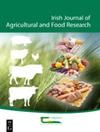The effect of antimicrobials on verocytotoxin bacteriophage transduction under bovine rumen fluid and broth conditions
IF 1.4
4区 农林科学
Q3 AGRICULTURE, MULTIDISCIPLINARY
引用次数: 0
Abstract
Abstract The verocytotoxin genes in verocytotoxigenic Escherichia coli (VTEC) are carried by bacteriophages, incorporated into the bacterial genome (prophage). Antibiotics may promote phage replication and release to infect other cells (transduction), thus leading to the emergence of new VTEC strains. This study investigated transduction of a verocytotoxin2-encoding bacteriophage (3538(vtx2::cat)) under laboratory conditions, including the effect of antibiotic treatments. Luria-Bertani Miller broth and rumen fluid (raw and sterilised by irradiation) were inoculated with the donor (C600φ3538(Δvtx2::cat)) and recipient (E. coli C600::kanamycinR) strains (4 log10 cfu/mL) and incubated at 38°C. Antibiotic treatments (minimal inhibitory and sub-inhibitory concentrations of ampicillin, cefquinome, oxytetracycline and sodium sulfamethazine) were applied after 3 h. Samples were tested for donor, recipient, cell-free phage and transductants at times t = 0, 3, 4, 6, 27 (24 h post-antibiotic treatment) and 51 h. Free phage was detected in the untreated broth and rumen samples, as were the transductants confirmed by polymerase chain reaction. The antibiotic treatments did not significantly (P > 0.01) increase the concentrations of free phage or transductants detected. It was therefore concluded that, under laboratory conditions, the antibiotics tested did not induce bacteriophage lysis, release and infection of new bacterial cells beyond that constitutively found in the phage population.在牛瘤胃液和肉汤条件下,抗菌剂对细胞毒素噬菌体转导的影响
摘要过量细胞毒性大肠杆菌(VTEC)中的过量细胞毒素基因由噬菌体携带,并整合到细菌基因组(原噬菌体)中。抗生素可能促进噬菌体复制和释放以感染其他细胞(转导),从而导致新的VTEC菌株的出现。本研究研究在实验室条件下研究了编码vercytoxin2的噬菌体(3538(vtx2::cat))的转导,包括抗生素治疗的效果。用供体(C600φ3538(Δvtx2::cat))和受体(大肠杆菌C600::卡那霉素R)菌株(4 log10 cfu/mL)接种Luria Bertani-Miller肉汤和瘤胃液(生的和辐照灭菌的),并在38°C下孵育。3小时后应用抗生素处理(最低抑制和亚抑制浓度的氨苄青霉素、头孢喹肟、土霉素和磺胺二甲嘧啶钠)。在t=0、3、4、6、27(抗生素处理后24小时)和51小时测试样品的供体、受体、无细胞噬菌体和转导子。在未处理的肉汤和瘤胃样品中检测到游离噬菌体,聚合酶链式反应证实的转导子也是如此。抗生素处理没有显著(P>0.01)增加检测到的游离噬菌体或转导子的浓度。因此得出的结论是,在实验室条件下,所测试的抗生素不会诱导噬菌体裂解、释放和感染新的细菌细胞,而不是在噬菌体群体中发现的细菌细胞。
本文章由计算机程序翻译,如有差异,请以英文原文为准。
求助全文
约1分钟内获得全文
求助全文
来源期刊
CiteScore
2.50
自引率
20.00%
发文量
23
审稿时长
>36 weeks
期刊介绍:
The Irish Journal of Agricultural and Food Research is a peer reviewed open access scientific journal published by Teagasc (Agriculture and Food Development Authority, Ireland). Manuscripts on any aspect of research of direct relevance to Irish agriculture and food production, including plant and animal sciences, food science, agri environmental science, soils, engineering, buildings, economics and sociology, will be considered for publication. The work must demonstrate novelty and relevance to the field of research. Papers published or offered for publication elsewhere will not be considered, but the publication of an abstract does not preclude the publication of the full paper in this journal.

 求助内容:
求助内容: 应助结果提醒方式:
应助结果提醒方式:


